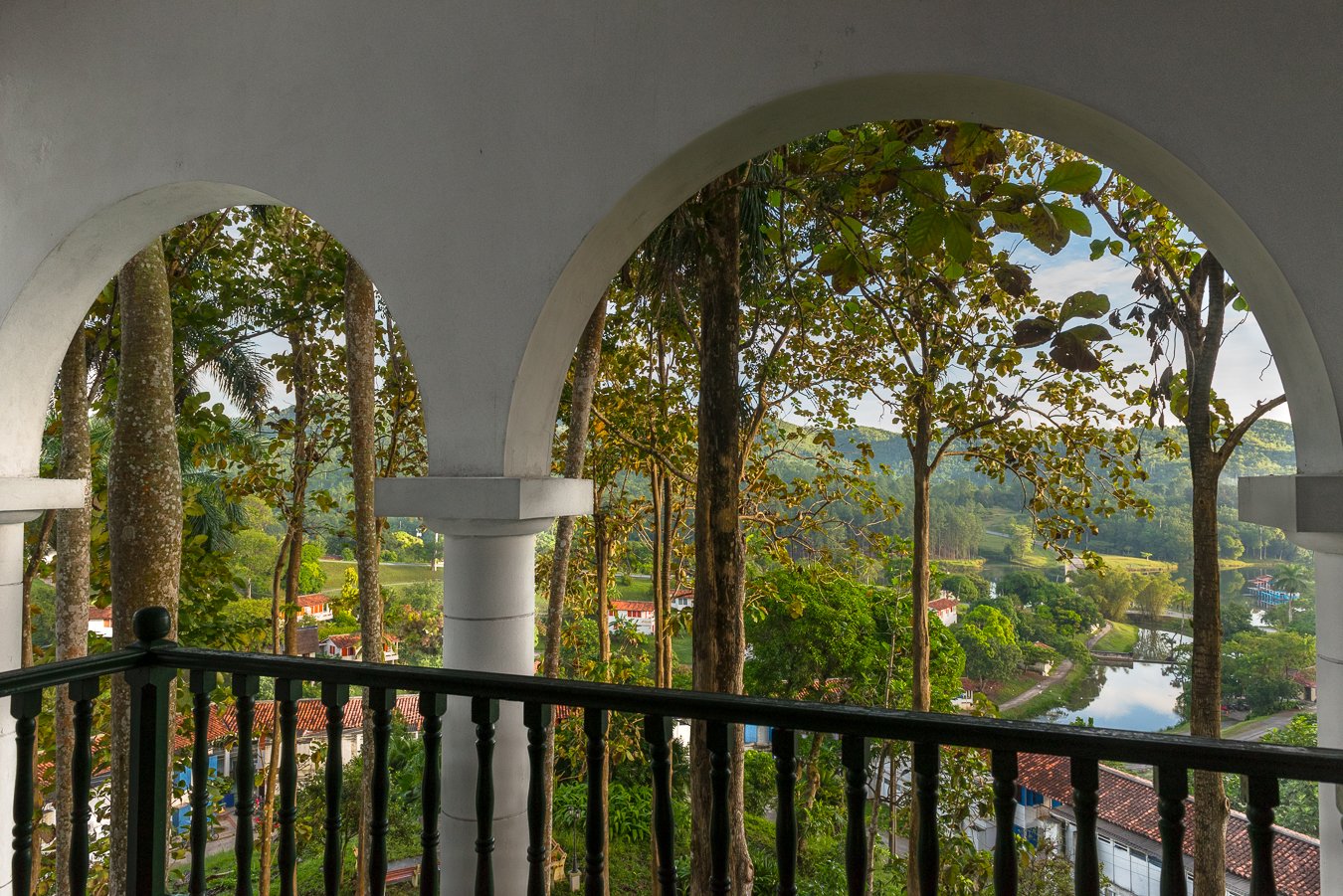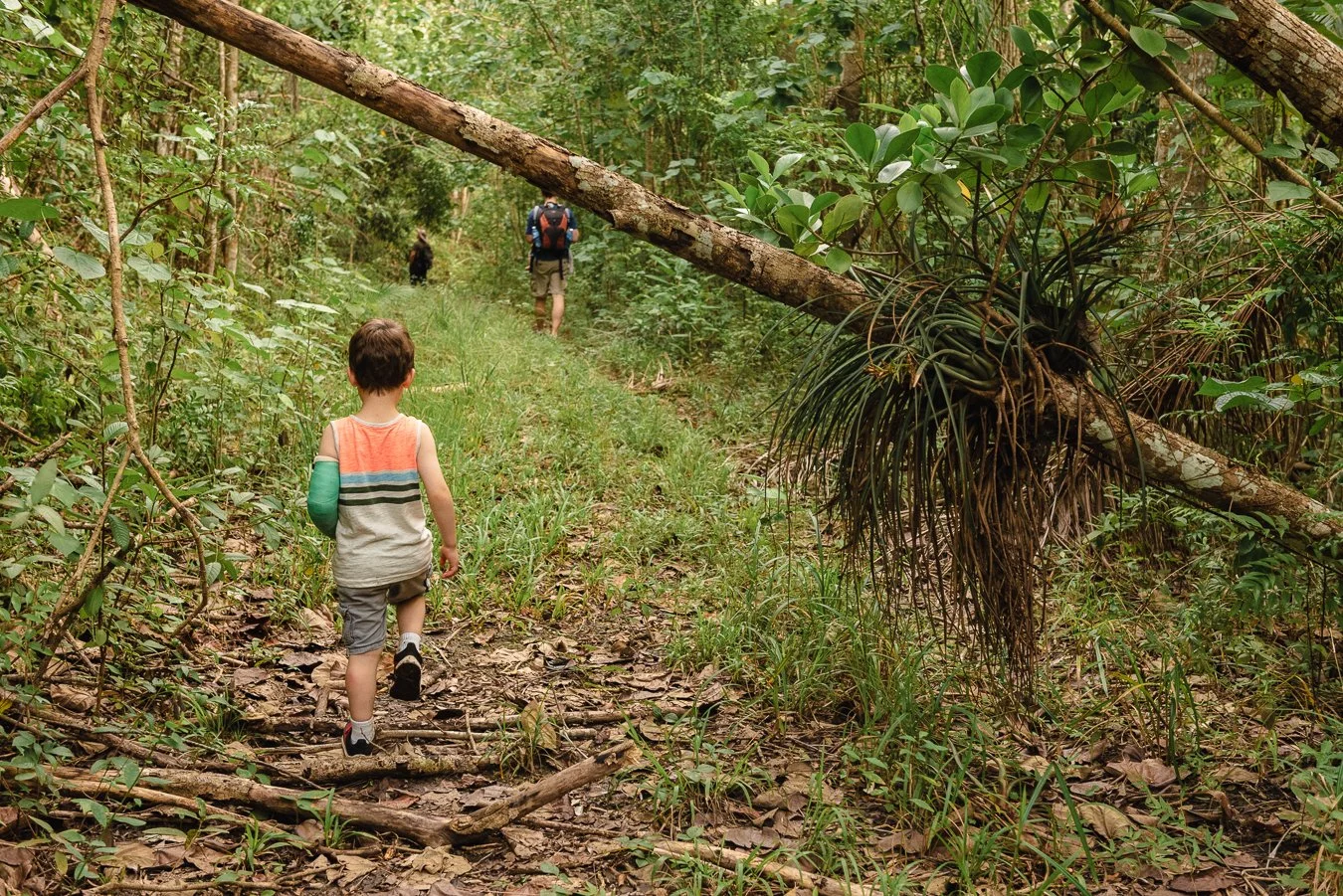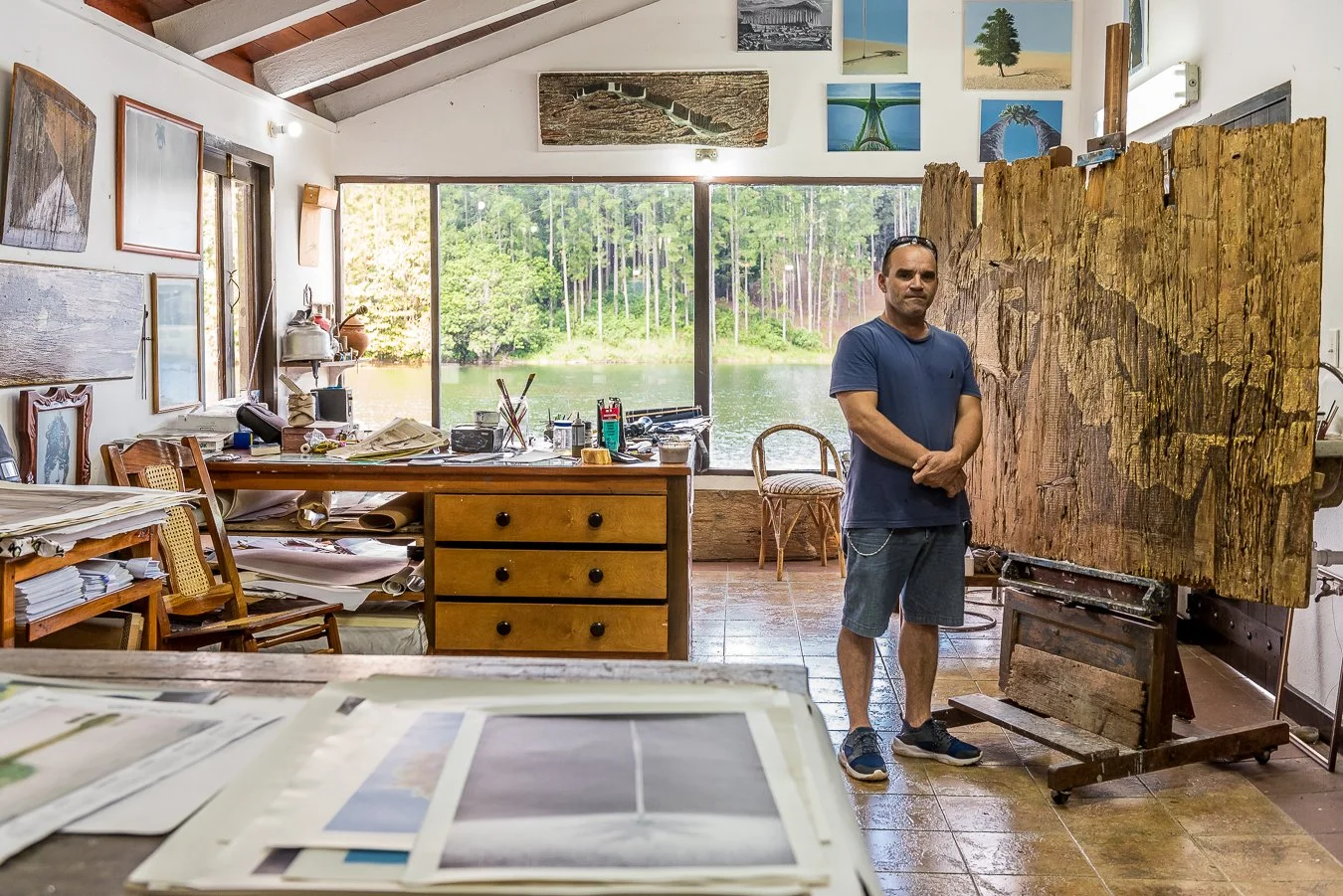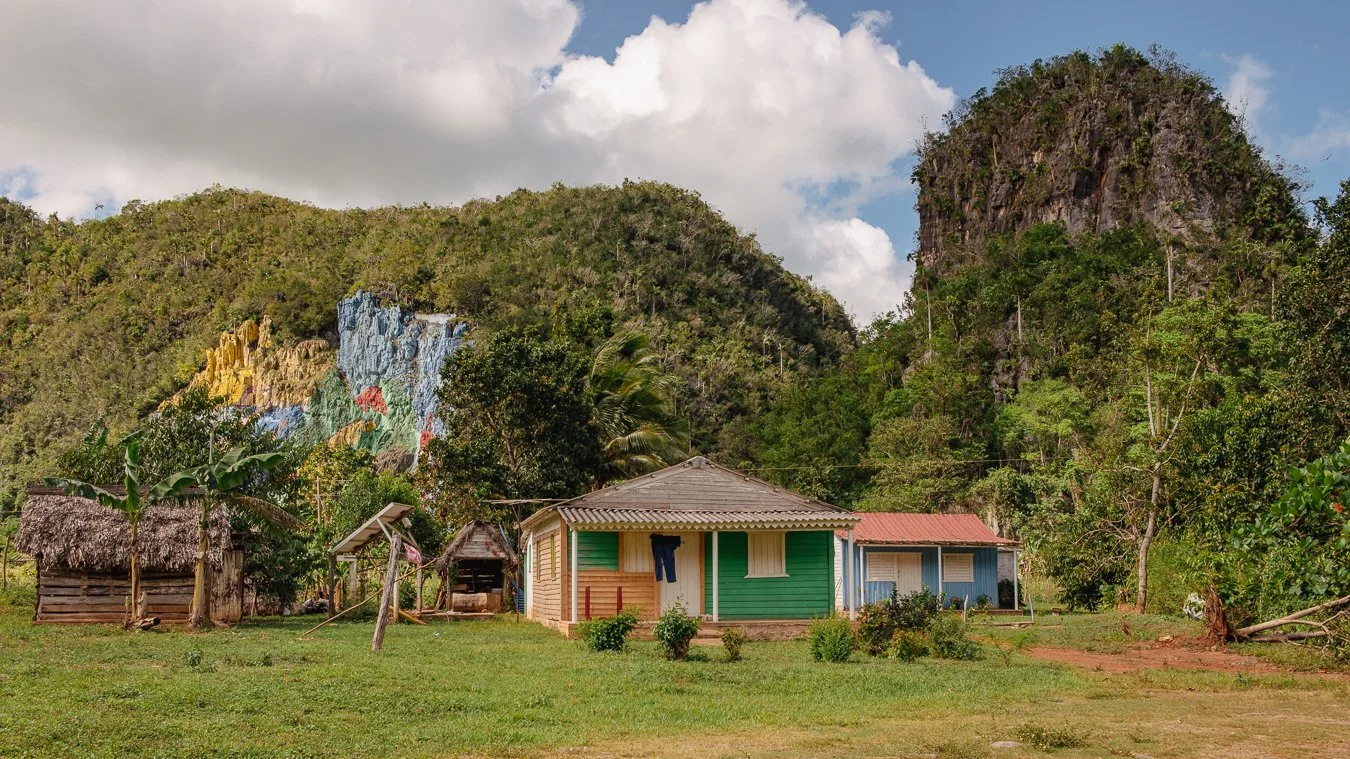Our family trip to Cuba with young children: Las Terrazas and Viñales
Originally published November 29, 2018. Updated March 8, 2025.
“When I first saw your family, I thought, ‘Who brings their young kids to Cuba on vacation?’”
Who indeed? This comment, from a kind American woman whose own kids are grown, was quickly followed by her laughing admission that she was living abroad when one of her kids was born, and traveled internationally when the baby was six weeks old, so she was actually quite supportive of our family trip.
While we had some major trepidations ahead of time about this particular vacation, the logistical challenges we anticipated weren’t as difficult as expected and were mostly self-generated (booking the wrong bus fare; not packing enough activities to occupy the kids in transit). Traveling with a teething baby and alternately homesick and fearless five-year-old, however, made things a little tougher.
Sitting on the footbridge at Las Terrazas.
We’re so glad to have experienced this beautiful, complicated country, though…especially before the anticipated influx of travelers from the US, now that it’s easier for Americans to travel there [2025 note: due to the COVID-19 pandemic and corresponding economic downturn, among other factors, combined with fluctuating travel restrictions, Cuba has not experienced the anticipated travel boom from the US and has faced an overall decline in tourism (1, 2)]. For anyone else traveling to Cuba with kids (or general-interest travelers to Cuba), I wanted to share Mike’s and my thoughts and basic itinerary in case it’s helpful, including what’s gone well and what we could have done differently.
View of Las Terrazas from the balcony of Hotel Moka. Photo: Emily Dahl
Getting to Cuba
We’re lucky to live near Boston, which already had relatively easy access to Cuba. We found a connecting flight down through Newark and a direct flight home. I was curious about why we could only see connecting flights for our departure until I heard on the news that the direct route was about to open in November [2025 note: this direct Boston - Havana route is no longer available].
We got our tourist visas at the United gate in Newark: our first lesson learned after booking was that our flight looked artificially inexpensive, as United charges more than other airlines for Cuban tourist cards ($75 vs ~$50 on other airlines, which adds up for a family of four) and charges for checked bags even internationally…as has become standard practice for many airlines now [2025 note: please confirm visa costs with your airline]. Aside from that, travel was relatively straightforward. The Havana international airport was perhaps not the most modern, but getting through immigration and customs was quick enough, and our bag and stroller arrived safely.
Las Terrazas: Family-friendly hiking, birdwatching, and sightseeing
We knew in advance that the tourist class Viazul buses only ran one or two times daily for most routes, so decided on a private airport pickup from Havana to get to our first destination: the eco-village of Las Terrazas.
Our hour-plus ride in a classic car turned out to be relatively comfortable. (Warning: no seatbelts! we brought the baby’s carseat and kept him buckled up, with it wedged into place…our five-year-old learned what seatbelt-free life was like when his grandparents were growing up and we spent a good portion of the drive asking him to stay put on the bench seat.) We were amazed at the great condition of the 1950s sedan. I’ve read elsewhere that these cars are quite expensive to maintain and parts hard to come by, which is easy to believe, and while we did see some in various states of disrepair, the majority that we as tourists saw on the streets as taxis were in good shape. We also learned that many have had their engines replaced with Russian Lada engines, which might account for their longevity—the newer cars on the road were mostly Ladas as well.
Classic Chevrolet.
After a smooth drive on an almost eerily traffic-free highway, we arrived at the bamboo-framed pond at the entrance of Las Terrazas. This is a community that looks pretty in photos but even more so in person. Temperatures stayed consistently pleasant, often with a light breeze, and the terraced hillsides for which the village is named were generally bathed in dappled sunlight. We chose Las Terrazas for its scenery, interesting history as a reforestation and sustainable development project, and hiking/birdwatching opportunities.
Hiking around Las Terrazas. Photo: Emily Dahl
Hotel Moka, built in 1994, is fringed with ferns and vine-wrapped, bromeliad-covered trees—and a large tree growing through the center of the open-air lobby and up through the ceiling. Our room’s balcony had great eye-level birdwatching and views of the village, and the shower had a full glass wall to look out at the canopy. The beds were comfortable, and the included breakfast buffet had an excellent mix of fresh fruits and fruit juices, yogurt, pastries, cheeses, and meats—along with the option to have eggs made to order. The only downside for us was the first night’s dinner, which took over two hours and was pricey by Cuban standards. It was, however, the only place we encountered during the trip with modern-style highchairs, which meant that we tried it again for a few other meals, with better results.
Hotel Moka: a lush, beautiful retreat in Las Terrazas. Photo: Emily Dahl
While at Las Terrazas, we took two guided hikes: walks in the forest are only allowed with guides, and as others have noted, trails are poorly marked. Both of our guides, Justo (at left in photo below, helping our older son cross a stream) and Leonardo (right, playing with the baby), were friendly and knowledgeable, and showed us areas we wouldn’t have seen on our own.
We also took a motorcycle-trailing-a-cab (moto-taxi?) to the mossy waterfalls of Baños de San Juan, and really liked that we were there with more Cubans than tourists enjoying themselves in the water. Before we left home, our Danny fell and broke his arm (or so we thought at the time—turns out it was a bone bruise), so he had it in a cast that we had to keep dry. Hence our beach-free itinerary, but he was able to wade around here, which he enjoyed.
Baños de San Juan: a wonderful experience with local Cubans. Photo: Emily Dahl
Our other stop was the Cafetal Buenavista, a former coffee plantation that had run on slave labor, which is now an educational site and restaurant. There’s also a walking trail, which we took partway toward a lookout (with small children, sometimes it’s OK not to reach the destination…we try to go with it).




In Las Terrazas, we found that walking around the village was one of the most enjoyable activities. The pond has a lovely footbridge spanning a spillway that’s a particularly nice spot around twilight.
A handful of artists sell their works out of their homes, including internationally known artist Lester Campa, whose studio we visited, and other artists including Henry Aloma. We bought several of his nature-inspired surrealist pieces that we’re excited to hang. We had heard that Cuba was a great country for purchasing interesting, reasonably priced art, and while we didn’t have a chance to explore much of Havana’s art scene, we did find this to be true in Las Terrazas.
Artist Lester Campa in his studio. Photo: Emily Dahl
From Las Terrazas, we took a Viazul bus to Vinales. While waiting at the gorgeous bus station in Las Terrazas overlooking a lake, we saw both of our tour guides, who played with our five-year-old as they waited for their next tour groups to arrive. The bus was great: clean, quiet, and spacious, with huge windows. Better yet, both kids slept for decent portions of the ride.
Panorama of Viñales at dusk. Photo: Emily Dahl
Viñales: Scenic views and mogote hiking
When we were considering visiting Cuba, seeing photos of Viñales Valley had clinched it for me. The karsite mogotes rising steeply from flat farmland, the light (though we found that everywhere we went in Cuba, the light had a beautiful quality), the colonial town, and the birding opportunities were some of the main draws.
For any fans of BBC’s adaptation of “Pride and Prejudice”—in my head, I kept replaying the scene in which Elizabeth Bennett first arrives in Derbyshire with her aunt and uncle. Seeing her thrilled reaction to its rocky beauty, Mr. Gardiner says, “Nature and culture in harmony, you see, Lizzy. Wildness and artifice, and all in the one perfect county.”
Viñales Valley is a UNESCO World Heritage Site for good reason. Part of what makes the landscape so stunning is this combination of nature and culture, wildness and artifice.
Our only big meal out was dinner at Balcon del Valle, which was widely recommended as the best place to view sunset over the mogotes. In the afternoon, we made a reservation in person for 5 PM, then walked just a few minutes to the lookout near the colorful pink Hotel Los Jazmines before returning to the restaurant for dinner.

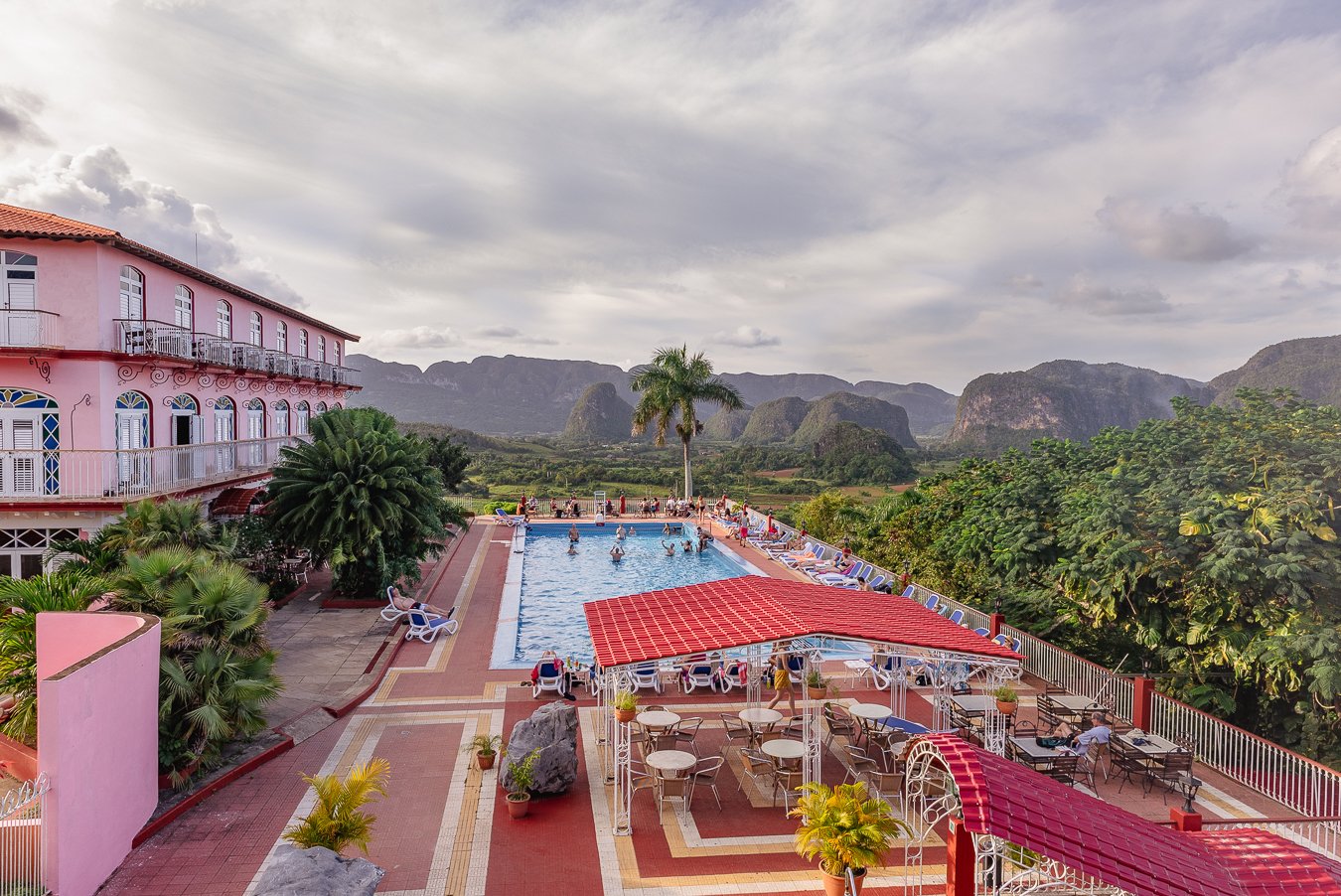



On a morning hike with a local guide who is also a journalist, we took dirt (mostly mud) paths through working farmland, past secadoras (tobacco-drying huts) and animal enclosures, to get to the base of one of the mogotes. Our older son climbed confidently up the narrow, zigzagging trail with Mike and our guide while I had the baby in his carrier, sleeping sweatily on me for some of the time.
Secadora - traditional tabaco-drying hut. Photo: Emily Dahl
We came to a plateau where we found a Cuban tody, the tiny, adorable bright green national bird, and saw a few more as we looked around—they flew quite close to us, seemingly undisturbed by our presence. By then, the sun was getting hot (morning hikes tended to begin a little later than our preferred time in Cuba), so we only stayed a few minutes before heading back down.
The other walk we did was around the Mural de la Prehistoria, which we didn’t see up close, but got decent views of from the nearby dirt road as we walked. We had a bait-and-switch experience where a supposed taxi driver handed us off to his friend, who then told us the price we’d been quoted for taking us to the mural and waiting for an hour while we walked around would not be enough, and that he’d only stay for a half-hour. Since we were low on funds because of the cash-only issue I’ll share more about, we agreed to this, but it meant that we didn’t make it all the way to a lookout point in the area. We could have easily spent another hour walking around, so for anyone else visiting, make sure you negotiate directly with the taxi driver before leaving to ensure you’ll have enough time.
Mural de la Prehistoria in the background, with color-coordinated house (intentional?). Photo: Emily Dahl
We also went to the botanical garden in Viñales (Jardin Botanico de Viñales), where we had what seemed like compulsory guiding around the grounds by a friendly young man who met us at the entrance. He whisked us around a little too quickly for us to really enjoy the garden and look at the plants, but was great with our older son, which made up for that. Since it’s a pretty child-friendly activity, we’d recommend it from that perspective.
Overall, it was easy to get around Viñales with the kids: it’s a very compact, walkable town, and the surrounding farmland was also nice (though definitely recommend a guide to get to any mogotes for hiking).





Remember: cash-only economy for Americans
One of the things to remember about Cuba, for now at least, is that US credit and debit cards don’t work. We knew that, though I’d heard about debit cards possibly working (not true in our case), but we still didn’t end up exchanging enough cash on arrival in Havana. By the time we got to Viñales, we were quite low on available funds. So aside from our guided hike, we kept our expenses and activities to a minimum until we could exchange more cash. We ate most of our meals at our bed and breakfast since it was just easier with the children, but had a few small meals around town.
In my next post, I’ll talk about our three days in Havana. Thanks for reading, and feel free to ask any questions about travel to Cuba in the comments!
Center for Responsible Travel. “History of US-Cuba Travel Policy.”
Reuters. “Cuba tourism struggles as blackouts and shortages deter visitors.” December 19, 2024.

